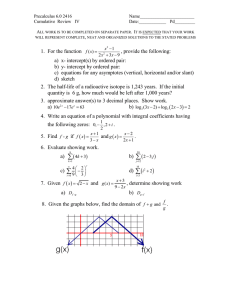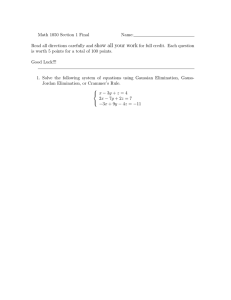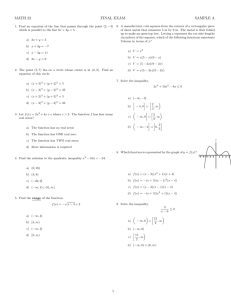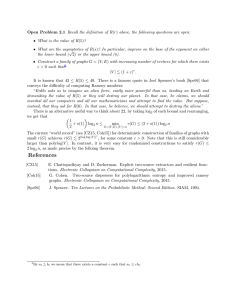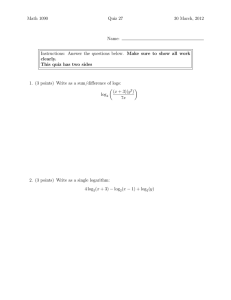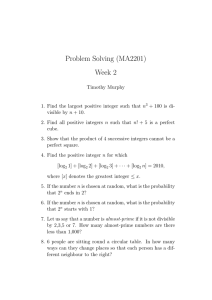Why4DNABases11IIT.ppt
advertisement
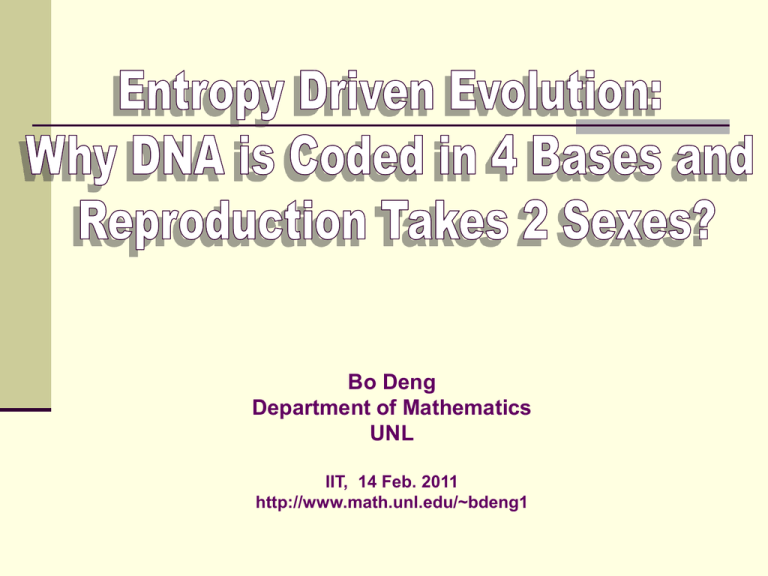
Bo Deng
Department of Mathematics
UNL
IIT, 14 Feb. 2011
http://www.math.unl.edu/~bdeng1
Working Hypothesis
Evolution is driven to maximize biodiversity against constraints
in time and energy across all biological scales
Applied to all informational systems:
o DNA Replication
o Protein Synthesis
o Sexual Reproduction
o Speciation to Phylogenetic Tree
o Ecological Community
o Animal Brain
o Consciousness
o Language
o Social, Economical, Political Structures
Channel
C. E. Shannon, ``A mathematical theory of communication,''
Bell System Technical Journal, vol. 27, pp. 379-423 and
623-656, July and October, 1948.
Claude E. Shannon
(1916-2001)
What is Information? and What Matters the Most?
All about choices
Transmission Speed Comparison
Dial-up
2400 bps ~ 56Kbps
DSL
128 Kbps ~ 8 Mbps
Cable
512 Kbps ~ 20 Mbps
Internet
Satellite
~ 6 Mbps
Optic Fiber
45 Mbps ~ 150 Mbps
Mathematical Measure of Information: What is in a bit?
One Bit = One Binary Digit
Dead Channel --- Transmit only one kind of symbol all the times
e.g. 0000…..
0 bit 0 bit information
Live Channel --- Transmit one of many possible symbols
each time, e.g. 011101… in a binary channel
Each transmitted symbol is either 0 or 1
Each symbol contains 1 bit information
Pop Quiz: How many bits in a quaternary symbol, 1, 2, 3, 4?
or in a symbol of n alphabets, 1, 2, 3, …, n?
Answer: H4 = 2 bits, and Hn = log2 n bits respectively
because 4 = 2 log2 4, n = 2 log2 n
# of sequences
length log n = # ofsymbol
choices n is just
0 or 1
Key
Assumption:
Each of
transmitted
Ex: { a, b, c, d } =
2
Bit Unit:
……
{ 00, 01, 10, 11}
one of n equally probable choices
What is in the transmission rate?
Let tk be time needed to transmit symbol k
Then the average transmission time per base is
Tn = (t1 + t2 + t3 +…+ tn ) / n
And the mean rate is
Rn = Hn / Tn = n log2 n / (t1 + t2 + t3 +…+ tn )
The definition implicitly assumes that all symbols occur
equally probable.
Why, or is it reasonable?
Recall: Rn = Hn / Tn = n log2n / (t1 + t2 + t3 +…+ tn )
All-purpose Channel
Each transmitted Symbol 1 is just one choice out of 1/p1
many possible
choices
therefore
Symbol 1spams,
contains
Internet
message
types:and
video,
audio, pictures,
…etc
log2 1/pfrequency
1 bits information
Each has different
distribution in the encoding
symbols
since 1/p1 = 2 log2 1/p1
Bit Unit:
0 or 1
1/p1 = # of sequences of length log 1/p1
……
2
Similarly, Symbol k contains log2 1/pk bits information
Example: Pick a marble from
Important
fact:
The average bits per symbol for our video only source is
Equiprobability
a bagp oflog
2 blue,
andH = log n
H(p) = H(p)
p1 log=2p1/p
+…+
1/p
<=
1 2 1/p1 +…+
n
2 pn log
n 2 1/pnn
2
1 log
5 read marbles
Probability
for picking
Conclusion:
For an all-purpose
channel,
the mean rate
Example
of Possible
Non-equiprobability:
a blue
marble:
is calculated
anyever
particular
source
If we know all
video files not
thatfor
have
transmitted
= 2/7source entropy,
entropy
but we
for can
thepmaximal
over the internet,
then
make
blue an accurate
Hn , which
reached
equaprobability
Number
of with
choices
for each blue picked
frequency table:
saypis
1 for Symbol 1, p2 for 2, etc, and
distribution
of the
symbols.
pn for symbol
n
1 /transmitting
pblue = 7/2 =3.5
Design Criterion
To choose n so that Rn = Hn / Tn
is the largest!
Example
Encoding states:
....
Symbols: 1
2
3
….
n
Trans. Times: t1
t2
t3
…
tn
Assume:
t1 = 1 sec, t2 = 2 sec, t3 = 3 sec, … , tn = n sec
Then
Rn = Hn / Tn = n log2n / (t1 + t2 + t3 +…+ tn ) = 2 log2 n / (n+1)
DNA Replication
James D. Watson (1928 -), Francis Crick (1916 - 2004), Molecular structure of nucleic acids,
Nature, 171(1953), pp.737--738.
http://www.mun.ca/biology/scarr/An11_01_DNA_replication.mov
Communication Model for DNA Replication
Fact:
DNA replication is the same for all genomes
Replication is a sequential process – one base a time
Observation:
Each species genome is an information source
Genome upon replication is a transmitted message
Conceptual Model:
DNA replication is an all-purpose channel
Questions:
Why 4 bases: A, T , C , G?
Replication Mean Rate: Rn = Hn / Tn ,
(per-base diversity rate)
Assumption:
Weaker chemical bonds take
longer to replicate (Heisenberg’s
Uncertainty Principle: t E ~ constant )
Time scale of a single Hydrogen
bond pairing: 4X10-15 sec.
Paring times of high energy bonds
are ignored (as a first attempt/order approximation
for the pairing time)
tA = tT = pairing time of one H…O bond = t0
tG = tC = pairing time of two H…O bond = 2 t0
t5 = t6 = pairing time of three H…O bond = 3 t0, etc.
(by Watson and Crick’s base paring principle)
The Result
Let k = # of base pairs, and
n = # of bases
Then
n=2k
Since t2m-1 =t2m = m t0 for m = 1,2, …, k
Rn = Hn / Tn = log2 n / [2(t1 + t3 + …+ t2k-1) /n]
= log2 n / [(n/2+1) t0/2]
A further refined model predicts
1.65 < tC,G / tA,T < 3 R4 = the optimal rate
1.8267
2 Sexes Problem
Sexual Reproduction is a process of information exchange
Reproduction Mean Ratio: Sn = Hn / En ,
Assumption:
Information payoff per-crossover base for n sexes:
Hn = log2 n
1:1 sex ratio with M members for each sex
Cost to sexual reproduction in energy and time is
inversely proportional to the probability of having
a reproductive group of n members having exactly
one sex each
Reproductive group is formed by random encounter
Reproductive Probability:
Reproductive Group in k Tries:
Expected Tries for One Reproductive Group :
Expected Tries for One Reproductive Group for Large Population :
The Result: Entropy-to-Cost Ratio: Sn = Hn / En ,
M = 10m
Genetic Entropy Exchange without Sexual but Existential Cost :
Multiparous Strategy
Multiparous Entropy:
Multiparous Cost :
Multiparous Entropy to Cost Ratio :
With Mixed (Random & Wedlock) Cost :
Discussions
n=4
Slower by
Evolutionary
Set-back by
n=2
< 0.75
> 25%
> 1 billion yrs
n=6
< 0.98
> 2%
> 80 million yrs
Rn / R4
a=2
Evolutionary Clock
Set-back with 3 Sexes:
Life on Earth could have not evolved faster and
have had a richer diversity at the same time
Consistent with Darwinian Theory of Survival-ofthe-Fittest theory but at the molecular level
Question: Was the origin of life driven by
informational selection?
The Role of Mathematics
Why is the per-base diversity measure by
Hn = log2 n or H ( p ) = S pk log2 1/pk
log2 1/(p1 p2) = log2 1/p1 + log2 1/p2 Information is additive
Mathematics is driven by open problems
Science is driven by existing solutions
Mathematical modeling is to discover the mathematics
to which Nature fits as a solution
Exception to the rule is the rule in biology
Acknowledgements
Dr. Reg Garrett, Department of Biology, University of Virginia,
regarding the GC transcription elongation problem
Dr. David Ussery, Center for Biological Sequence Analysis,
Technical University of Denmark, on most base frequency data
Dr. Daniel Smith, Department of Biology, Oregon State University,
regarding the base frequencies of P. ubique
Dr. Tony Joern, Department of Biology, UNL, Kansas State University
Dr. Etsuko Moriyama, the Beadle Center for Genetics Research,
University of Nebraska-Lincoln
Dr. Hideaki Moriyama, Dr. Xiao-Cheng Zhen,
Department of Chemistry, University of Nebraska-Lincoln
Irakli Loladze, David Logan, Department of Mathematics, UNL
The show of life is on your DNA channel
We are consumers of
reproductive entropy
Genome
Base Frequency
A
T
G
C
d
S. coelicolor
13.9
14.0
36.1
36.0
0.1%
-44.2%
E. coli K-12
24.6
24.6
25.4
25.4
0.0%
-1.6%
E. coli O15:H7
24.8
24.7
25.2
25.2
0.1%
-1.0%
Human*
29.4
29.7
20.5
20.4
0.3%
18.2%
P.ubique
35.3
35.0
14.9
14.8
0.3%
40.6%
W. glossinidia
38.8
38.7
11.2
11.3
0.1%
55.0%
* Base frequency for the chromosome 14 which has the largest d.
d max{ | p A pT |, | pG pC |}
( p A pT ) ( pG pC )
Viruses are taking advantage of the replication system
by having the near maximal per-base diversity entropy
and having their hosts do the replication for them.
Genome
Base Frequency
A
T
G
C
d
H ( p)
phage P1
26.1
26.6
23.5
23.8
0.5%
5.4%
1.9978
phage T4
31.8
32.9
16.5
18.8
2.3%
29.5%
1.9355
phage VT2-Sa
25.6
24.5
26.9
23.0
3.9%
0.2%
1.9976
phage 933W
27.6
22.8
27.4
22.2
5.2%
0.8%
1.9927
phage phiX174
24.0
31.3
23.3
21.5
7.3%
10.6%
1.9846
max.
2.0000
To Maximize Stationary Entropy:
H(p) = p1 log2 1/p1 +…+ pn log2 1/pn
1.8267
Genome
1.8267
Base Frequency
A
T
G
C
d
**
H ( p) t A,T R( p)
S. coelicolor
13.9
14.0
36.1
36.0
0.1%
-44.2%
1.8538
1.1623
E. coli K-12
24.6
24.6
25.4
25.4
0.0%
-1.6%
1.9998
1.4093
E. coli O15:H7
24.8
24.7
25.2
25.2
0.1%
-1.0%
1.9999
1.4122
Human*
29.4
29.7
20.5
20.4
0.3%
18.2%
1.9834
1.4005
P.ubique
35.3
35.0
14.9
14.8
0.3%
40.6%
1.8774
1.5081
W. glossinidia
38.8
38.7
11.2
11.3
0.1%
55.0%
1.7688
1.4921
* Base frequency for the chromosome 14 which has the largest d.
**a 1.8267
Others have to scramble with individual
and absolute Channel Capacities, i.e.,
Objective: Max. R(p) = H (p) / T (p)
Subject to: p1 + p2 + …+ pn = 1, pk > 0
Optimization Result:
pA pT , pG pC
pG pAa, a tG,C /tA,T
K = max R(p) = (log2 1/pA) /tA,T



